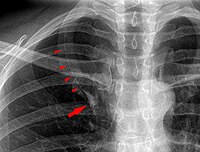
Photo from wikipedia
During lung development many internal and external factors can influence normal lung maturation. Mechanical ventilation and oxygen supplementation of preterm infants triggers bronchopulmonary dysplasia, a chronic lung disease characterised by… Click to show full abstract
During lung development many internal and external factors can influence normal lung maturation. Mechanical ventilation and oxygen supplementation of preterm infants triggers bronchopulmonary dysplasia, a chronic lung disease characterised by enlarged septa thickness and less alveoli. Recently, several new methods for lung morphological analysis have been established, such as the stereological analysis of lungs embedded in plastic. A comparative, quantitative analysis of the structure of individual lung lobes has never been undertaken. In the present study, single lung lobes isolated from C57Bl/6 mice exposed to normoxia (21% O2) or hyperoxia (85% O2) from the day of birth for 14 days, were embedded in plastic, and analysed by stereology. For the whole-lung, the mean septal wall thickness was significantly increased from 10.2 μm in 21% O2 to 15.3 μm in 85% O2. In the single lobe study, the septa thickness was increased only in the caudal and left lobe from 11.4 μm in 21% O2 to 15.2 μm in 85% O2 and 11.6 μm in 21% O2 to 14.2 μm in 85% O2, respectively. The alveolar density in the whole-lung was decreased from 1.6 × 107 cm−3 in 21% O2 to 0.7 × 107 cm−3 in 85% O2. In contrast, the single lobe analysis revealed a higher alveolar density in the cranial lobe 2.2 × 107 cm−3 and in the middle lobe 2.0 × 107 cm−3 in 21% O2, which was also noted in the in 85% O2, at 1.3 × 107 cm−3 and 1.4 × 107 cm−3, respectively. The stereological study of each single lung lobe individually was more accurate and precise compared with the whole-lung analysis. Moreover, individual lung lobes in mice might follow a different development patterns, and this should be further investigated.
Journal Title: European Respiratory Journal
Year Published: 2017
Link to full text (if available)
Share on Social Media: Sign Up to like & get
recommendations!